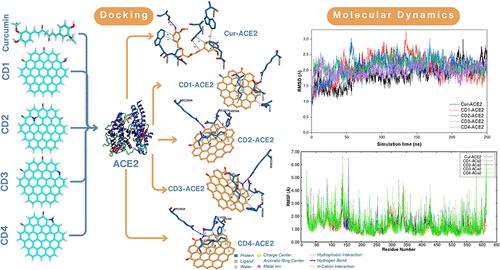Our official English website, www.x-mol.net, welcomes your feedback! (Note: you will need to create a separate account there.)
Theoretical Investigation of the Green-Synthesized Carbon-Based Nanomaterial Potential as Inhibitors of ACE2 for Blocking SARS-CoV-2 Binding
ACS Omega ( IF 4.1 ) Pub Date : 2024-03-27 , DOI: 10.1021/acsomega.4c00759 Harsiwi Candra Sari 1 , Haliza Hasnia Putri 1 , Pinantun Wiguna Kusuma Paksi 1 , Gabriel Hidayat 1 , Silmi Rahma Amelia 1 , Citra Deliana Dewi Sundari 2, 3 , Heni Rachmawati 4, 5 , Atthar Luqman Ivansyah 1, 6 , Fahdzi Muttaqien 1, 6 , Ferry Iskandar 5, 6, 7
ACS Omega ( IF 4.1 ) Pub Date : 2024-03-27 , DOI: 10.1021/acsomega.4c00759 Harsiwi Candra Sari 1 , Haliza Hasnia Putri 1 , Pinantun Wiguna Kusuma Paksi 1 , Gabriel Hidayat 1 , Silmi Rahma Amelia 1 , Citra Deliana Dewi Sundari 2, 3 , Heni Rachmawati 4, 5 , Atthar Luqman Ivansyah 1, 6 , Fahdzi Muttaqien 1, 6 , Ferry Iskandar 5, 6, 7
Affiliation

|
Since the emergence of SARS-CoV-2 in 2020, the world has faced a global pandemic, emphasizing the urgent need for effective treatments to combat COVID-19. This study explores the use of green-synthesized carbon-based nanomaterials as potential inhibitors of ACE2, a critical receptor for SARS-CoV-2 entry into host cells. Specifically, the study examines four carbon-based nanomaterials, namely, CD1, CD2, CD3, and CD4 in amino, graphitic, pyridinic, and pyrrolic forms, respectively, synthesized from curcumin, to investigate their binding affinity with ACE2. Molecular docking studies revealed that CD3 (pyridinic form) exhibited the highest binding affinity with ACE2, surpassing that of the control compound, curcumin. Notably, CD3 formed hydrophobic interactions and hydrogen bonds with key ACE2 residues, suggesting its potential to block the binding of SARS-CoV-2 to human cells. Moreover, molecular dynamics simulations demonstrated the stability of these ligand-ACE2 complexes, further supporting the promise of CD3 as an inhibitor. Quantum chemical analyses, including frontier molecular orbitals, natural bond orbital analysis, and the quantum theory of atoms in molecules, unveiled valuable insights into the reactivity and interaction strengths of these ligands. CD3 exhibited desirable chemical properties, signifying its suitability for therapeutic development. The study’s findings suggest that green-synthesized carbon-based nanomaterials, particularly CD3, have the potential to serve as effective inhibitors of ACE2, offering a promising avenue for the development of treatments against COVID-19. Further experimental validation is warranted to advance these findings and establish new therapies for the ongoing global pandemic.
中文翻译:

绿色合成碳基纳米材料作为 ACE2 抑制剂阻断 SARS-CoV-2 结合潜力的理论研究
自 2020 年 SARS-CoV-2 出现以来,世界面临着一场全球大流行,凸显了迫切需要有效的治疗方法来对抗 COVID-19。本研究探索使用绿色合成的碳基纳米材料作为 ACE2 的潜在抑制剂,ACE2 是 SARS-CoV-2 进入宿主细胞的关键受体。具体来说,该研究检查了四种碳基纳米材料,即由姜黄素合成的氨基、石墨、吡啶和吡咯形式的 CD1、CD2、CD3 和 CD4,以研究它们与 ACE2 的结合亲和力。分子对接研究表明,CD3(吡啶形式)与 ACE2 表现出最高的结合亲和力,超过了对照化合物姜黄素。值得注意的是,CD3 与关键 ACE2 残基形成疏水相互作用和氢键,表明其具有阻止 SARS-CoV-2 与人类细胞结合的潜力。此外,分子动力学模拟证明了这些配体-ACE2复合物的稳定性,进一步支持了CD3作为抑制剂的前景。量子化学分析,包括前沿分子轨道、自然键轨道分析和分子中原子的量子理论,揭示了这些配体的反应性和相互作用强度的宝贵见解。 CD3表现出理想的化学特性,表明其适合治疗开发。该研究的结果表明,绿色合成的碳基纳米材料,特别是 CD3,有潜力作为 ACE2 的有效抑制剂,为开发针对 COVID-19 的治疗方法提供了一条有前途的途径。需要进一步的实验验证来推进这些发现并为当前的全球大流行建立新的疗法。
更新日期:2024-03-27
中文翻译:

绿色合成碳基纳米材料作为 ACE2 抑制剂阻断 SARS-CoV-2 结合潜力的理论研究
自 2020 年 SARS-CoV-2 出现以来,世界面临着一场全球大流行,凸显了迫切需要有效的治疗方法来对抗 COVID-19。本研究探索使用绿色合成的碳基纳米材料作为 ACE2 的潜在抑制剂,ACE2 是 SARS-CoV-2 进入宿主细胞的关键受体。具体来说,该研究检查了四种碳基纳米材料,即由姜黄素合成的氨基、石墨、吡啶和吡咯形式的 CD1、CD2、CD3 和 CD4,以研究它们与 ACE2 的结合亲和力。分子对接研究表明,CD3(吡啶形式)与 ACE2 表现出最高的结合亲和力,超过了对照化合物姜黄素。值得注意的是,CD3 与关键 ACE2 残基形成疏水相互作用和氢键,表明其具有阻止 SARS-CoV-2 与人类细胞结合的潜力。此外,分子动力学模拟证明了这些配体-ACE2复合物的稳定性,进一步支持了CD3作为抑制剂的前景。量子化学分析,包括前沿分子轨道、自然键轨道分析和分子中原子的量子理论,揭示了这些配体的反应性和相互作用强度的宝贵见解。 CD3表现出理想的化学特性,表明其适合治疗开发。该研究的结果表明,绿色合成的碳基纳米材料,特别是 CD3,有潜力作为 ACE2 的有效抑制剂,为开发针对 COVID-19 的治疗方法提供了一条有前途的途径。需要进一步的实验验证来推进这些发现并为当前的全球大流行建立新的疗法。



























 京公网安备 11010802027423号
京公网安备 11010802027423号